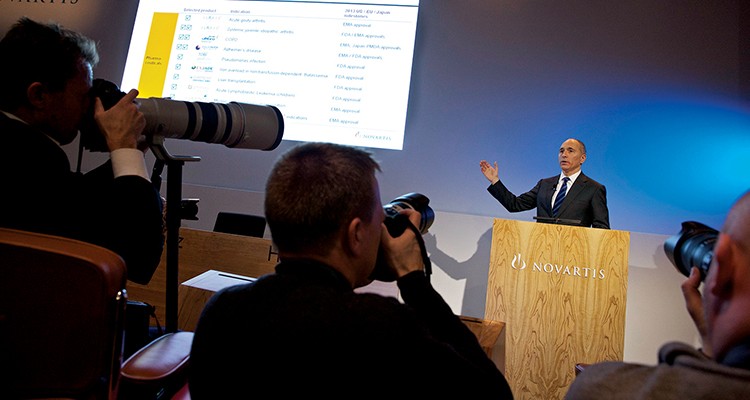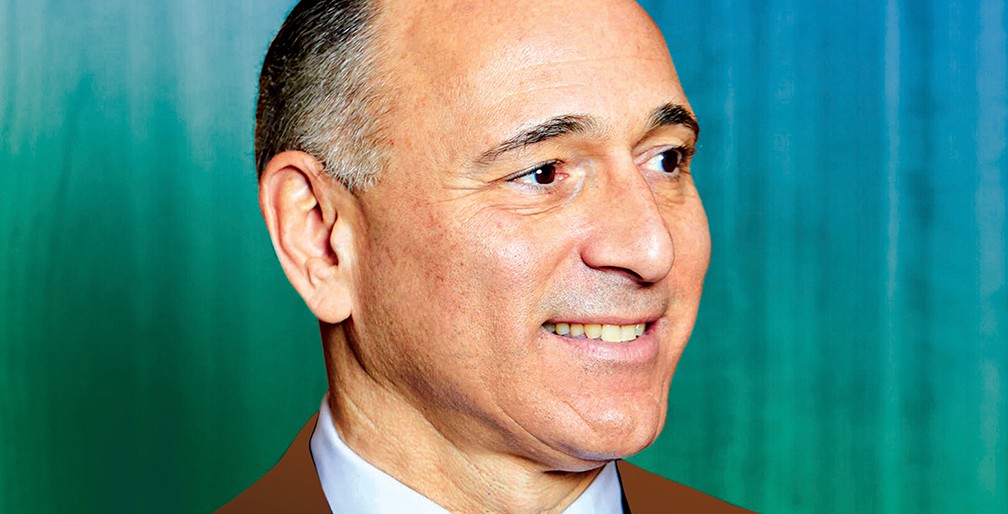Novartis’ purpose is to discover new ways to improve and extend people’s lives.
This reason for being was Joseph Jimenez’s North Star during his eight-year tenure as CEO of the health care giant. It shaped organizational strategy, motivated change, drove decision-making and influenced spending. “We were willing to put our money where our science is,” Mr. Jimenez says.
That purpose also catalyzed Mr. Jimenez’s efforts to drive an industrywide transformation.
“I’ve been a big proponent of shifting away from a transactional approach in pricing to an outcomes approach,” Mr. Jimenez says. “Research estimates that about 25 percent of all [health care] spending is wasted because a positive patient outcome is not granted. People go into the hospital when they don’t need to or they are given a drug that genetically they’re not going to respond to.”
Shifting the pricing structure to focus on outcomes—where all parties responsible for delivering care, from drugmakers to hospitals to mental health workers get paid only when a treatment works—will both reduce patients’ expenses and also improve the industry’s sustainability. According to a report released by the World Economic Forum in April 2017, health care costs are growing at roughly twice the rate of the gross domestic product, putting severe pressures on health care budgets and constraining research and development (R&D).
“We were willing to put our money where our science is.” —Joseph Jimenez, former CEO, Novartis
The shift toward outcomes has been slow to catch on globally, however. But a revolutionary new treatment with a controversial price tag recently brought the conversation into the mainstream in a major way.
Last August, just five months before Mr. Jimenez stepped down from his post at the Basel, Switzerland-based company, the U.S. Food and Drug Administration approved its first gene therapy drug, Kymriah. Developed by Novartis, the drug treats pediatric and young adult patients living with acute lymphoblastic leukemia (ALL). Each dose is customized using the individual’s own T-cells, which are collected and modified to include a new gene that directs the T-cells to target and kill leukemia cells with a specific antigen. The genetically modified cells are then infused back into the patient to kill the cancer cells.
The drug costs $475,000 per one-time dose, a price tag that has some critics calling foul. In a letter to Mr. Jimenez, David Mitchell, president and co-founder of the advocacy group Patients For Affordable Drugs, argued that “the price should be fair and take into account the contribution that American citizens already made to the basic and translational science behind [the drug].” The group points out that much of the early research on the drug was done at the University of Pennsylvania while the U.S. National Institutes of Health provided funding for that work.
Mr. Jimenez, an American himself, stood by the cost, citing one major caveat: If Kymriah does not work to treat ALL after 30 days, the patient and his or her insurer will not be charged. The move raised some eyebrows, to say the least. “It was a huge internal debate,” he says. “You could tell that people—not just at Novartis, but people in this industry—scratched their heads and said, ‘You’re taking on risks. It is much better if you just have a transactional approach because then you are certain to get paid.’”
But Mr. Jimenez believes this risk assessment is too shortsighted. In the long term, he sees the current economic model as a threat to global health care systems—the systems pharma companies rely on.
“Those systems have to reimburse our innovation,” he says. “So if we don’t help create sustainability in the health care system, someday our products are not going to get reimbursed.”
Changing the health care system is a crucial yet slow-moving step toward advancing Novartis’ purpose. Share on X But ultimately it is worth the effort. According to Mr. Jimenez, purpose drives better employee engagement and improves product development. And it is what continues to help Novartis stay afloat in the choppy waters health care companies must navigate today.
But he says organizations do not have to be in the business of life and death to benefit from a well-defined purpose.
“Novartis is lucky to be able to be in an industry where we have a significant impact on mankind in extending life and improving the quality of life,” he says. “But I think that whether you make medicine or tortilla chips, every company can and should have a purpose that is important.”
“Whether you make medicine or tortilla chips, every company can and should have a purpose that is important.”
—Joseph Jimenez
Find the Rallying Point
When he was the senior captain of Stanford University’s swim team in 1982, Mr. Jimenez used to motivate his tired teammates by reminding them on an individual basis that the only way out is through. When he was a young executive at Clorox and, later, ConAgra Foods, he would motivate teams with pep talks in small huddles. But as head of a global company with 120,000 employees worldwide, Mr. Jimenez no longer could have that kind of personal contact.
That distance was especially troubling for him when hard decisions had to be made in his early days as Novartis’ CEO. In 2010, during his first months on the job, he was tasked with finalizing a $51.6 billion acquisition of eye care company Alcon. A few months after that, he had to start a plan for the loss of patent protection on two of Novartis’ most important medications—Femara, a cancer fighting drug, and Diovan, a market-leading high blood pressure medication. Both patents were due to expire in 2012.
 It was a critical moment. When drug patents expire, sales of the name-brand market leaders often drop by half or more as cheaper generics flood the market. And, at Novartis, Diovan sales in 2012 accounted for $4.4 billion of the company’s then $56.7 billion in annual sales.
It was a critical moment. When drug patents expire, sales of the name-brand market leaders often drop by half or more as cheaper generics flood the market. And, at Novartis, Diovan sales in 2012 accounted for $4.4 billion of the company’s then $56.7 billion in annual sales.
Contraction of some kind was imminent. To rally Novartis’ 120,000 employees, Mr. Jimenez put the focus on purpose. By engaging employees with purpose, they were reconnected with the organization and more passionate about what they were doing—and why.
“I started bringing patients who had benefited from Novartis products into meetings—management meetings, manufacturing site-level meetings, all types of meetings,” he says. “We’d start the meetings with a patient story that was either about how a Novartis product changed that patient’s life or how it changed one of their family members’ lives.”
The move resonated, he says. It reminded employees that their work at Novartis mattered, regardless of how the bottom line fluctuated.
But it was only the first step.
Going Viral
The way Mr. Jimenez saw it, fulfilling the mission of discovering new ways to extend and improve lives required Novartis to spend less money pushing its products and more on developing better products. That meant increasing investment in R&D and the creation of efficient manufacturing facilities.
Reinvention, Mr. Jimenez knew, only would work if a majority of employees embraced the new focus on purpose. To build buy-in, Mr. Jimenez launched a program called Long Live Life in 2012. Through this program, the company asked associates to share photos, stories and ideas about friends, family or anyone else who had benefited from a Novartis product.
“Even though we have 120,000 employees, Long Live Life showed me that it really wasn’t that hard to reach people because we’re all so connected online,” he says.
In the voluntary program’s first year, 80 percent of all employees or associates visited the internal Long Live Life website. Some 64 percent of these participants, in 95 countries, posted pictures and shared 400 video stories.
“It became viral,” Mr. Jimenez says. “It became personal. People were connecting, electronically, all over the world. They were telling stories about the noble cause we were engaged in. Then, when we did our annual employee engagement survey, we were quickly able to see that engagement levels had gone way up. I really believe that was because we connected our people to the purpose of the company in a meaningful way.”
Long Live Life had started as a project—something intended to run for only a few years as the company dealt with significant changes in its business. “But it turned into a movement,” Mr. Jimenez says. “It took off by itself, and it’s still going. It’s not a glossy program today; it’s really an organic movement.”
Be Ready to Act
The only way for a drugmaker like Novartis to discover new ways to improve and extend people’s lives is to go out in search of those discoveries. In Mr. Jimenez’s view, that means having a robust, continually developing pipeline of products.
For instance, just as Novartis’ leukemia treatment Gleevec lost its patent protection, Novartis introduced a new cancer drug (Afinitor) and a multiple sclerosis drug (Gilenya), the latter of which reached $2.5 billion in global sales in 2014. Simultaneously, it had 58 other products in development for potential launch by 2019.
Mr. Jimenez learned how to develop and keep that kind of active pipeline in production while working in consumer goods: He led North American operations at H.J. Heinz from 2002 to 2007 before becoming a division head at Novartis Pharmaceuticals. He brought that same sensibility to Novartis, refocusing the company’s expenditures on R&D and streamlining the workflow at Novartis’ manufacturing plants. Procurement savings for the company totaled more than $2 billion through 2015, and in turn helped create highly productive product pipelines. Having those, he says, was critical because so many pharma products now in development are likely to fail before they come to market.
“I told people that failure is a way of life here, and that our best people will fail the most because that’s how medical science advances.”
—Joseph Jimenez
“When we start drug discovery and development, only about 10 percent of what we start actually gets launched,” he explains. “I told people that failure is a way of life here, and that our best people will fail the most because that’s how medical science advances. That’s why we’re constantly combing through the pipeline, terminating those projects that don’t seem promising and reallocating our resources to those projects that look like they can become new and important medicines.”
Not all of the company’s teams have the same margin for error. Mr. Jimenez says the biggest misstep of his Novartis career was not recognizing soon enough that the company’s acquired Alcon eye care division did not have a product line that would keep it growing at the 5 to 6 percent annual rate that Novartis expected when his predecessor committed to buying Alcon in 2010.
“Because of its difference from pharmaceuticals, we kept Alcon a bit at arm’s length,” Mr. Jimenez says. “We said, ‘This is a great management team that knows what they are doing.’ But we then had some new product failures, and I feel like I didn’t intervene early enough to get that new product pipeline back on track. It moved from that business being a growth engine to a drag on the company.”
Alcon net sales slumped 3 percent from 2015 to 2016, and the division posted an operating loss of $132 million after having a gain of $281 million the year before. To turn things around, Mr. Jimenez shook up the product lines, moved some of Alcon’s operations into Novartis’ pharmaceutical divisions and set up a monthly Innovation Management Board composed of Alcon and Novartis division heads, R&D executives and Mr. Jimenez himself. “Every month we would go through ongoing projects,” he says. “If there was a product failure or even the beginning of a hint of a product failure, we were able to act fast.”
That affinity for efficiency and innovation might just be the inspiration for Mr. Jimenez’s second act. Shortly after he became ex-CEO of Novartis in February—although he remains available for consultation until his official retirement in August—Mr. Jimenez moved back to Silicon Valley, close to where his grown children now live. The move also could be the lure Mr. Jimenez needs to stay in the health care industry. “When I think of what really excites me, it’s where biology comes together with technology, like when you think about what’s happening right now in the Valley in California,” he told Forbes. “The thing that needs to be fixed is the inefficiency in the U.S. health care system. This is a system that is going to implode based on the burden of disease, for instance, Alzheimer’s disease. How are we going to pay for the innovation that’s coming? The only way is to get rid of the inefficiency in the system. That’s where I see digital technology starting to have a significant impact.”




